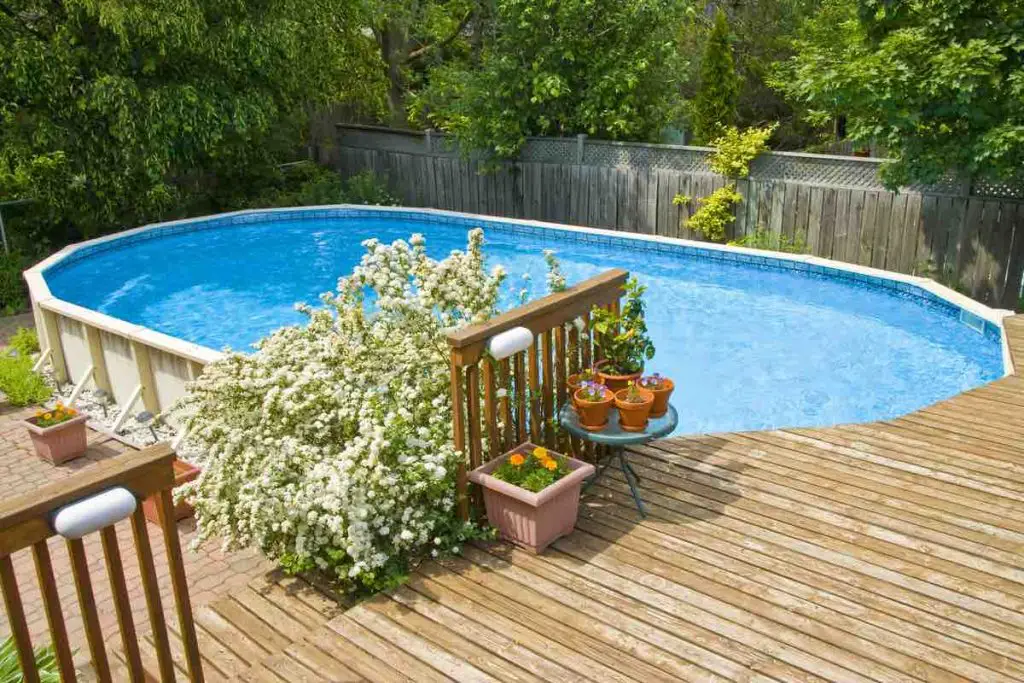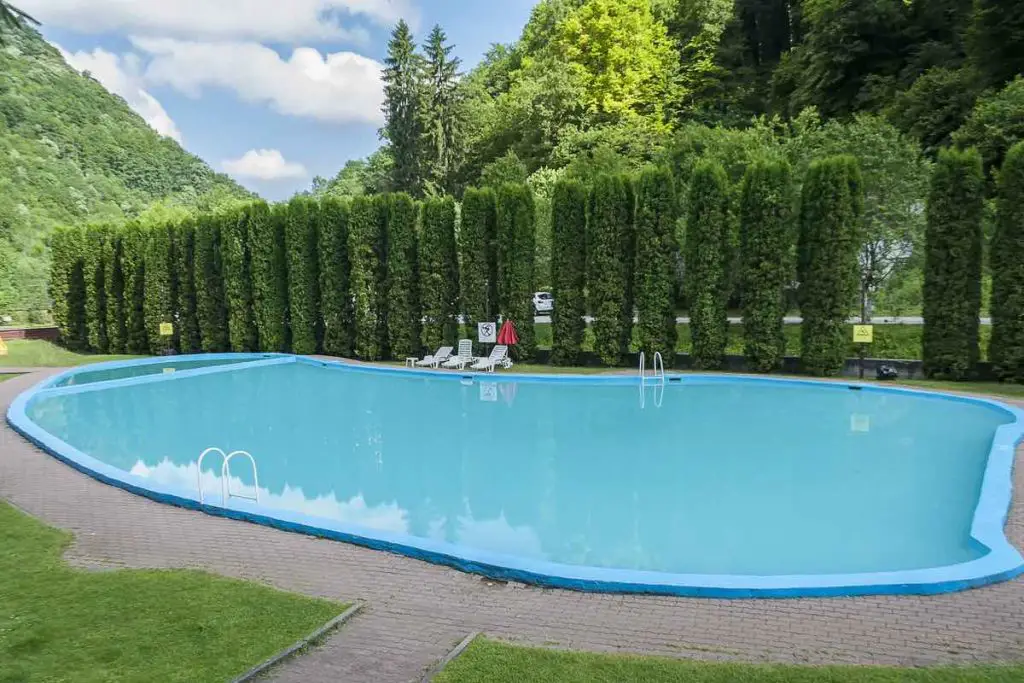If you have trees and plants around your swimming pool, the pool water may occasionally splash onto them. But, could this pool water be toxic enough to kill off trees and plants? Meager quantities are unlikely to cause harm to the plants.
Pool water with a chlorine level of 0.5 parts per million (ppm) or more is enough to kill nearby trees and plants. Some trees tend to be more susceptible to chlorine toxicity than others. Nonetheless, chlorine toxicity in plants can be corrected by conducting early diagnosis and treatment.
This article will look into signs of chlorine damage in plants and trees and how to make pool water safe for plants. I will also share some remedies for plants and trees with chlorine toxicity and how to prevent it in the first place.

Chlorine Toxicity in Plants and Trees
Pool water is treated with chlorine because of its disinfecting properties, which keep the swimming pool free of germs.
Plants and trees benefit from chlorine, which is an essential macronutrient. Excess chlorine in pool water that gets in contact with your plants can build up in leaves, causing chlorine toxicity.
Leaves are essential to tree and plant growth because they are the primary site of photosynthesis. When left untreated, chlorine toxicity can cause irreversible damage to plant leaves, causing stunted growth and, eventually, dead plants and trees.
Moreso, excess chlorine in trees and plants causes dehydration, resulting in premature wilting of leaves.
How Can Pool Water Get to Nearby Plants and Trees?
Chlorine-treated pool water may splash onto nearby plants when there is an activity in the water or when draining out the swimming pool for maintenance/over winter. Additionally, a pool leak can allow pool water to sip into the soil, thereby being taken up by nearby plants and trees.
One may also consider using pool water to irrigate nearby plants and trees as a matter of convenience. For more information on chlorine levels in pools take a look at The Beginners Guide to Pool Water Chemistry.
Let’s look into vital indicators that can help you to diagnose the early signs of chlorine toxicity.
Signs of Chlorine Toxicity in Plants and Trees
In small, diluted quantities (less than 0.1 ppm), the chlorine-treated pool water does not pose much risk to nearby plants and trees. However, once the threshold is exceeded, you may notice chlorine toxicity in the plants.
Here are some signs you should look out for:
- Leaves with scorched tips
- Leaves turning yellow.
- Unusually smaller leaves.
- Necrotic lesions on leaves.
- The wilting and premature dropping of leaves.
- Dying plants and trees (when left untreated for a long time).
Plants and Trees More Susceptible to Chlorine Toxicity
Some plants are more susceptible to chlorine toxicity than others. Several vegetable and fruit plants are also more sensitive to this condition. So if you plan to grow trees close to your swimming pool, you may want to watch out for some species. These plants include:
- Box Elder and Maple families
- Pin Oak
- Siberian Crabapple
- Dogwood
- Horse Chestnut
- Sweet Gum
- Yellowwood
- Ash
- Mulberry trees
How To Treat Chlorine Toxicity in Plants and Trees
Fortunately, it is possible to leach excess chlorine deep into the ground beyond the reach of the roots of plants and trees around your pool to protect them from further damage.
These remedies will help you treat chlorine toxicity in affected plants and trees:
- Regular irrigation with chlorine-free water. The caveat is that you must ensure the soil has good drainage because water-logged soil can cause root rot in plants and trees. Watering affected plants and trees with pure water will leach out excess chlorine.
- Apply gypsum to the affected soil. Gypsum has an alkaline pH and helps to neutralize chlorine toxicity in soil. Before using gypsum, conduct a soil test with the help of a professional who will advise as to whether it is the best course of action.
Unfortunately, leaves that have suffered damage, such as scorching and discoloration from chlorine toxicity, cannot be restored, so you have to wait for new leaves to grow before assessing the success of the treatment.
Regular soil tests will also help you know whether the treatment has worked and whether the soil requires any additional nutrients.
How To Protect Nearby Trees and Plants From Toxic Pool Water
Taking proper protective measures will prevent your plants and trees from severe reactions to the toxic pool water.
The following strategies will help you protect your plants and trees from chlorine toxicity when draining your pool:
- Do not add more chlorine tablets if you intend to drain your pool soon.
- Let the pool remain uncovered for two weeks to let any remaining chlorine evaporate.
- Make use of dechlorination tablets, which are much faster and more effective (heed the manufacturer’s instructions before use). You should note that this option is not eco-friendly, and the chemicals used are toxic to animals. However, you can use the green option, which is Vitamin C dechlorination tablets.
- You can use sodium thiosulphate, which is an EPA-recommended dechlorination agent.
- Do not switch off the water pump during dechlorination, as the water movement allows for thorough chlorine elimination.
- Inquire about the use of carbon absorption filters from an expert. Though this method is the most expensive, it is also the most effective at removing chlorine from pool water.
- Consider directing pool water to the combined sewer system if you cannot effectively dechlorinate it.
If you only need to dechlorinate a small amount of pool water to irrigate nearby trees and plants, you don’t have to dechlorinate the entire pool. Fetch the quantity you need into a bucket, and leave it for a week to allow all the chlorine to evaporate. Afterward, you can use the water for irrigation.

Conclusion
Chlorinated pool water with a concentration higher than 0.1 ppm is enough to cause chlorine toxicity in nearby plants and trees, primarily seen in damaged leaves. When the chlorine concentration exceeds 0.5ppm, the surrounding plants and trees may wilt and die.
Occasional splashes of chlorinated water may not do much harm to plants and trees. If you need to drain the pool or there is a leak, the toxic water may pose a significant risk to the nearby vegetation.
Sources
- Jain Irrigation USA: Chlorine in your Water: Does it Harm Plants?
- Las Vegas Review-Journal: Chlorinated Pool Water Not Safe for Irrigating Plants
- Tucson: Pool Chemicals Harm Plants
- The Pool Co: Can Pool Water Kill Your Plants or Lawn?
- University of Maryland Extension: Chorine Toxicity
- Iowa State University: Chlorine Toxicity
- The Sacramento Bee: How Do I Dechlorinate Water to Irrigate Trees?
- Flourishing Plants: Watering Plants with Pool Water: The Do’s and Donts
- WikiHow: 3 Ways to Dechlorinate Pool Water
- Accepta: Sodium Thiosulphate Dechlorinator
- National Library of Medicine: Chloride as a Beneficial Macronutrient in Higher Plants: New Roles and Regulation
- National Geographic: Photosynthesis
